One of America’s oldest states, Connecticut is part of the nation’s Atlantic region. Along with its neighbors, New York and New Jersey, it also makes up the Tri-state area, one of the most urbanized and densely populated regions in the entire world. So surely, there’s no room for things like snakes, much less venomous ones … right?
It may come as a surprise that not only do snakes inhabit Connecticut but that there are actually 14 different species! If this is frightening, don’t worry; only 2 species are venomous, and they aren’t interested in people. Here, we’ve gathered some information about the most notable snakes that inhabit the Constitution State.
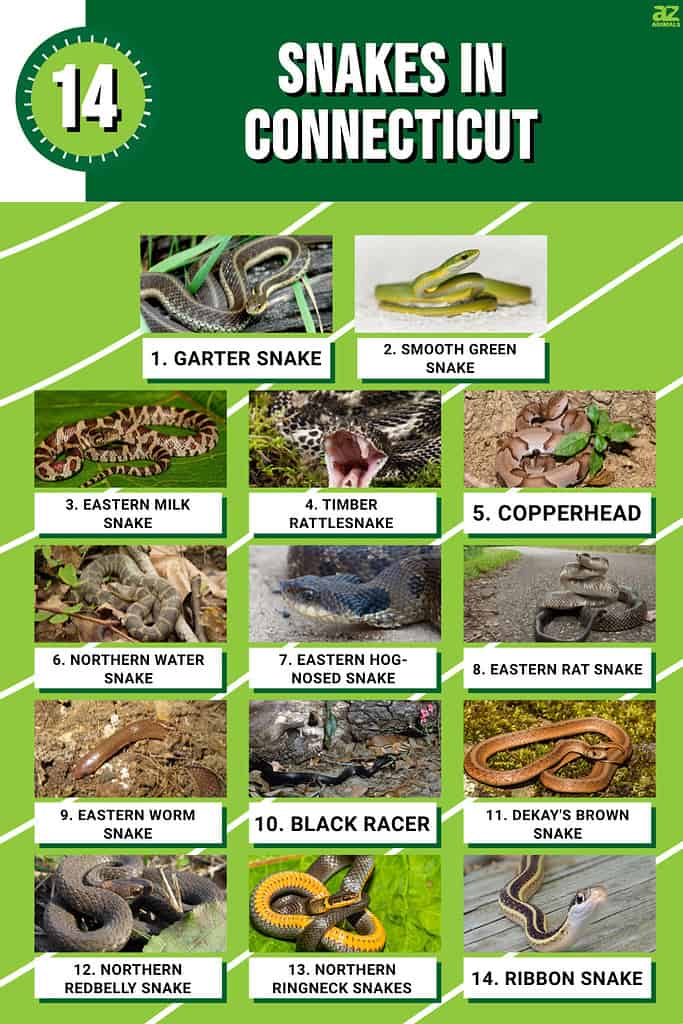
5 Common Snakes in Connecticut
Of Connecticut’s 14 snakes, some are more common than others. Here are three of the more common (but not poisonous!) snakes that can be found in Connecticut.
Eastern Garter Snake
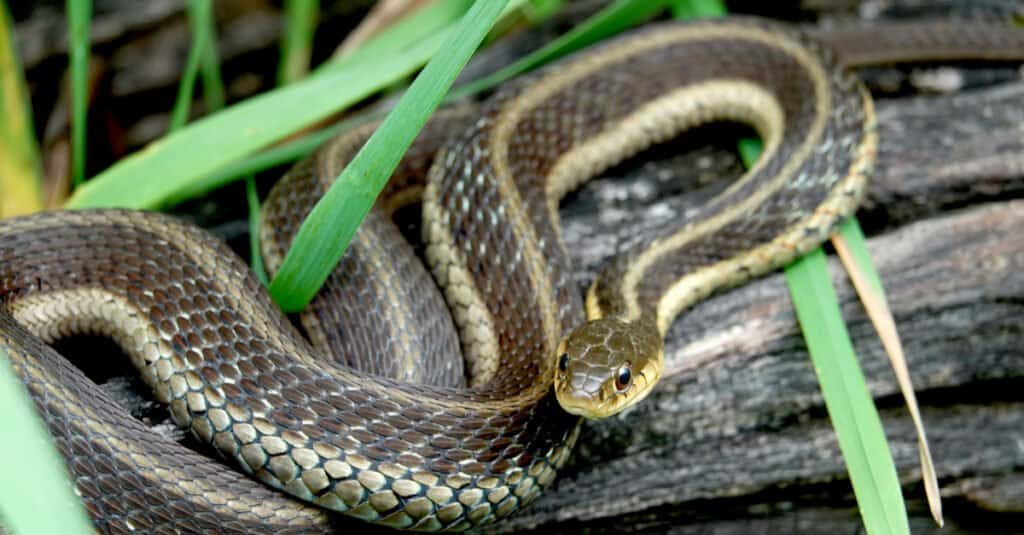
Eastern garter snakes are found across Connecticut.
©Erik Agar/Shutterstock.com
This is the most common snake in Connecticut. Though an eastern garter snake may surprise some when it pops out from a small crevice, it poses no threat whatsoever to humans.
At a maximum length of just over 3 feet, it’s far too small to threaten us. Even if you corner and capture one, it will only unleash a smelly musk meant to make predators back off in disgust. It may also bite, but since it’s a nonvenomous snake, the bite won’t cause any permanent damage unless it gets infected.
Since the eastern garter snake is too small to eat people, it prefers to stick to its diet of amphibians, worms, fish, and slugs. For this reason, it likes to hang out around grassy areas with some kind of water source, such as a pond or stream.
Since Connecticut is so urbanized, the eastern garter has adapted to its environment, making homes out of lawns, parks, farms, and gardens. So if you see a green, brown, or black snake with a yellow or white stripe running down its back, it’s probably a garter. These snakes have little in common with Connecticut’s venomous snakes; on the contrary, they are known to make fantastic pets.
Smooth Green Snake
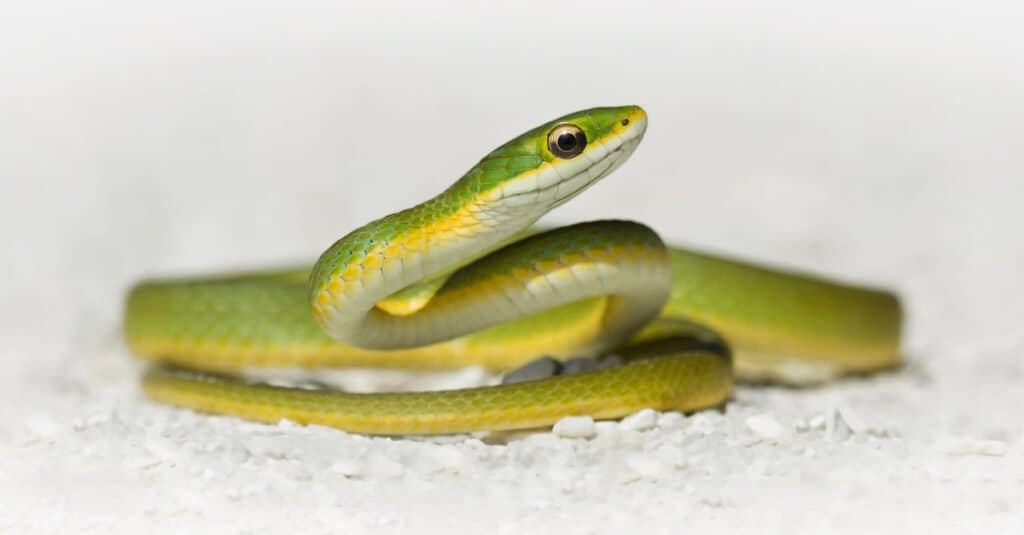
Smooth green snakes feed on insects and spiders, which means they can help control pests!
©Kristian Bell/Shutterstock.com
There is much to love about the smooth green snake. For one, it bears a rejuvenating light green coloring that is unmistakable. It is also extremely non-threatening, feeding only on insects and spiders, meaning that these beauties make for excellent natural pest control. Finally, it lives up to the “smooth” part of its name, making it fun to hold should one ever get the chance.
Unfortunately, the smooth green snake is endangered in Connecticut and protected by its Endangered Species Act. However, worry not; this snake is flourishing across other states.
Also called grass snakes, the smooth green snake is right at home in grasslands, pastures, and open woodlands. They have excellent camouflage in the grass, blending right into the environment to sneak up on prey or hide from predators. Good luck spotting a 20-inch green snake hidden in your bright green lawn. In fact, it may surprise you when you approach one by mistake, and it takes off in a hurry.
In the winter, they are even better hidden, since they hibernate from October to April in burrows and anthills. Here’s a fun fact for you: since their prey is so small, smooth green snakes are some of the only snakes that neither constrict their prey nor inject it with venom, electing to instead down it in one bite. Good thing we aren’t bugs.
Eastern Milk Snake
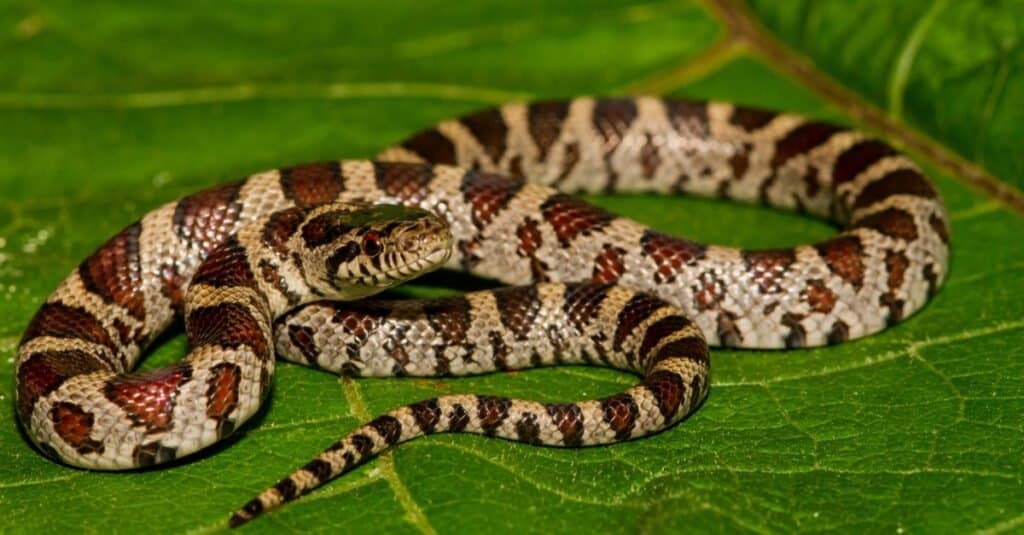
Eastern milk snakes are often mistaken for venomous snakes, but they’re not one of Connecticut’s two venomous snakes!
©Jay Ondreicka/Shutterstock.com
Another nonvenomous snake, the eastern milk snake, is a little bigger than the ones we’ve covered so far, reaching a maximum of 3 feet. A common sight in barns, this snake got its name from a rumor that it broke into said barns to drink milk from the cows.
While this rumor is false, the milk snake does enter barns to find its preferred prey of mice. However, its palette is quite large, and it will also feed on worms, fish, insects, lizards, slugs, birds, and bird eggs, to name a few.
The eastern milk snake makes its home in fields, forests, and rocky areas across Connecticut and much of the eastern U.S. However, this shy snake prefers to spend time underground and under the cover of logs, rocks, and man-made debris. You’ll recognize one by its tan coloring, dark red-brown blotches, and, most distinctively, a gray or tan mark on the back of its head shaped like a Y or V.
If you see one, there’s no need to worry. In fact, since its blood is resistant to the venom of other snakes, it makes a meal out of them as well. Thus, having a milk snake near your home could be good for you and your family!
Venomous (Poisonous) Snakes in Connecticut
Connecticut is home to two venomous snakes. Let’s take a look at each one with a picture so you can identify them in any encounters!
Copperhead
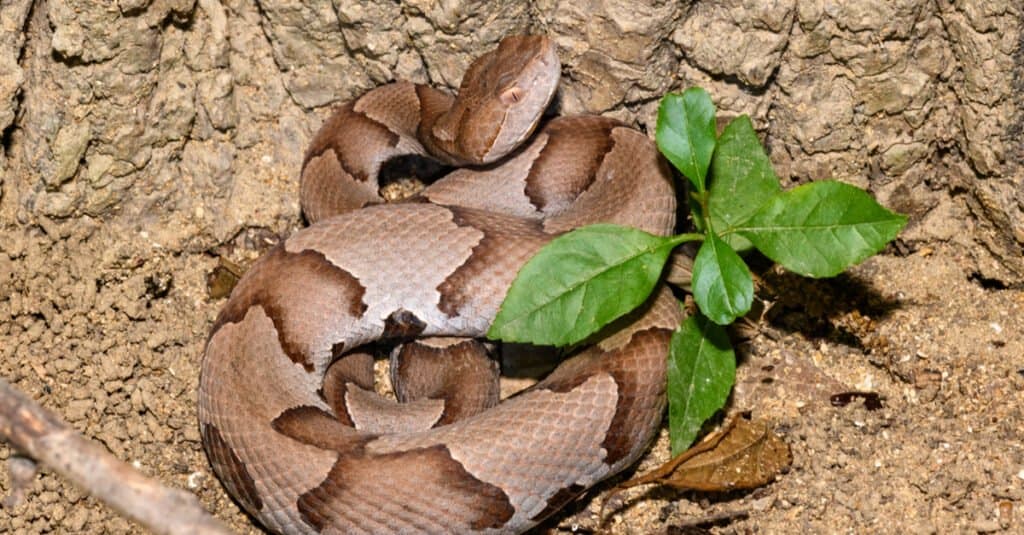
Copperheads are one of Connecticut’s two venomous snakes.
©Jeff W. Jarrett/Shutterstock.com
The copperhead is the first of two venomous snakes in Connecticut, lying at the northeastern end of its range. You can find them throughout the state, particularly in the south. Luckily, the copperhead is distinct from nonvenomous snakes in a few ways.
Though its entire body is tan-brown, its broad head has a distinct copper coloring, giving it its name. Its eyes have elliptical pupils, which are shaped like slits, similar to a cat’s eye. Also, keep an eye out for darker blotches on its body that may be shaped like hourglasses.
The copperhead prefers to use venom on prey including small animals like birds, rodents, and frogs. It is far too small to eat a person and only bites as a last resort. Before doing this, it will try to make you leave it alone. First, it will freeze in place, hoping that you don’t notice it. If that fails, it may try to fake you out or deliver a “dry bite,” which is a bite with no venom.
If faced with these warning signs, put some distance between yourself and the copperhead, and it should leave you alone. If bitten, seek treatment immediately, and you’ll almost certainly live. Still, it’s best to keep an eye open in the woodlands of southern Connecticut for these potentially deadly snakes. They are most active during spring and autumn.
Timber Rattlesnake

The timber rattlesnake is the largest venomous snake in Connecticut.
©Joe McDonald/Shutterstock.com
Connecticut’s other venomous snake is also the biggest on this list, topping out at 5 feet. However, the timber rattlesnake is a rare sight in the state and, like the smooth green snake, is protected by its Endangered Species Act. It is becoming increasingly rare throughout the northeastern United States, though it flourishes more out west.
Despite being rare in Connecticut, you may find it in most parts of the state, especially in its center. It can be found in various habitats as well, including fields, forests, thickets, and floodplains. For those interested, the timber rattlesnake is the “Don’t Tread on Me” snake and is displayed on the 1775 Gadsden Flag bearing that phrase.
As the only rattlesnake in Connecticut, it should be one of the easiest to identify; just look for its rattle! This also provides it with an audial warning, so if you happen to hear a rattle in the Connecticut wilderness, you’ve probably wandered too close to one. If you look down, you’ll probably see a 3- to 5-foot snake colored yellow-brown, gray, or black, covered in dark blotches.
This snake likes to lie in wait for mammals, frogs, and smaller snakes, but it’s a calm animal that rarely bites people. It will try to scare you off with its rattle and some posturing, so take the hint and back off. Timber rattlesnakes might be impressive animals, but they want nothing to do with people, so if you wish to avoid the risk that comes with their potent venom, our advice is simple: don’t tread on them.
Water Snakes in Connecticut
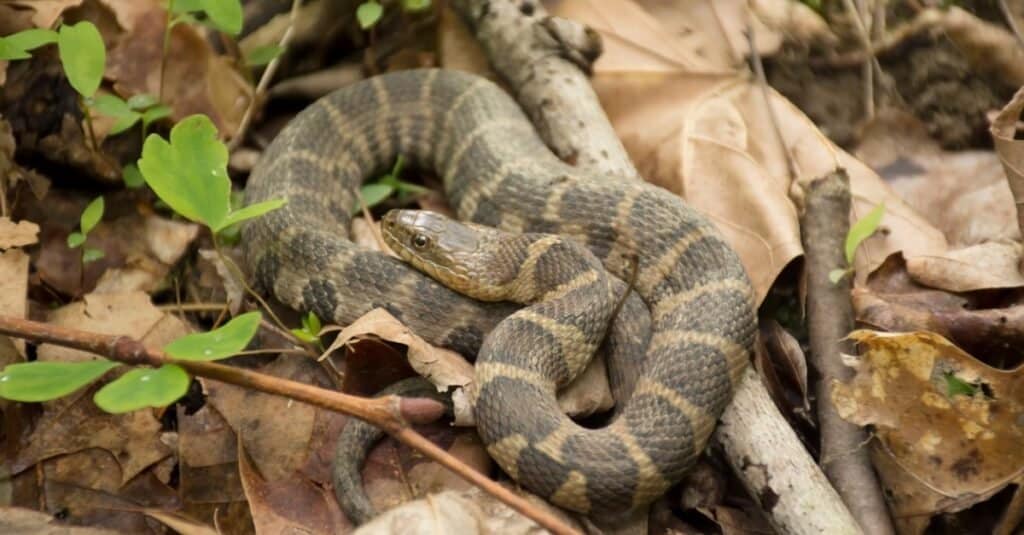
The northern water snake has a flat head that is as wide as its neck.
©iStock.com/IcemanJ
If you’re in an aquatic environment and spot a snake, the primary water snake in Connecticut is the northern water snake. Northern water snakes are not poisonous but are often confused with other snakes such as the cottonmouth. They’re relatively common across wetlands, streams, and rivers in the state. The species feed primarily on fish, amphibians, insects, and crayfish. Water snakes can reach more than four feet in length but pose little threat to people.
Summary of Common Snakes in Connecticut
Here’s a brief recap of the common snakes in Connecticut that we’ve taken a detailed look at:
| Number | Snake | Type |
|---|---|---|
| 1 | Eastern Garter Snake | Non-Venomous |
| 2 | Smooth Green Snake | Non-Venomous |
| 3 | Eastern Milk Snake | Non-Venomous |
| 4 | Copperhead | Venomous |
| 5 | Timber Rattlesnake | Venomous |
| 6 | Northern Water Snake | Non-Venomous |
Other Reptiles Which Live in Connecticut

Five-lined Skinks are capable of growing to 3 inches and can be found in three counties in Connecticut
©James DeBoer/Shutterstock.com
Five-lined skinks: These reptiles are known for their gleaming skin and which is dark brown marked by cream-colored stripes which run down the length of their bodies. They are capable of growing to 3 inches and can be found in Hartford, Litchfield, and New Haven counties.
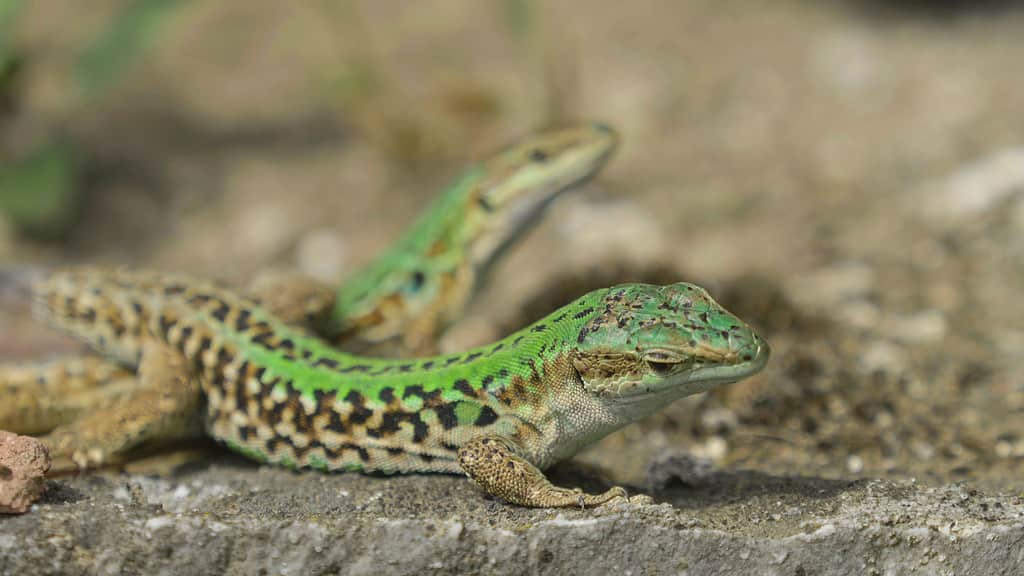
Although not native to the United States, Italian wall lizards have settled down and can be found in Fairfield County.
©MEDIAIMAG/Shutterstock.com
Italian Wall Lizards: Introduced from the Italian Peninsula, these relative newcomers in ecological terms, have made themselves quite at home in Connecticut (Fairfield County) as well as California and New York. They generally grow up to 4 inches and have a brown and green coloration with varying patterns. They are insectivorous although some also enjoy nibbling on flowers and leaves, too.
Summary of 14 Snakes in Connecticut
| Index | Species |
|---|---|
| 1 | Garter Snake |
| 2 | Smooth Green Snake |
| 3 | Eastern Milk Snake |
| 4 | Timber Rattlesnake (venomous) |
| 5 | Copperhead (venomous) |
| 6 | Northern Water Snake |
| 7 | Eastern Hog-Nosed Snake |
| 8 | Eastern Rat Snake |
| 9 | Eastern Worm Snake |
| 10 | Black Racer |
| 11 | DeKay’s Brown Snake |
| 12 | Northern Redbelly Snake |
| 13 | Northern Ringneck Snakes |
| 14 | Ribbbon Snake |
Final Thoughts
Some Connecticut residents might be surprised to learn of dangerous snakes living in their state. But, before you start worrying, remember that both venomous snake species are relatively docile and only hunt for small animals. Humans are far too big for them to consume, so they treat them like one of their own predators.
They will hide from you, and if that fails, they will try to scare you away. Very few people in the U.S. die of snakebites each year, especially in Connecticut. As long as you learn what these snakes look like, leave them alone, and, if the worst should happen, seek medical treatment immediately, the chance of serious injury from a snake is extremely low.
We also hope that you learned a bit more about the various snakes of Connecticut! There are 14 that inhabit the state, including those that we haven’t covered in more detail today. Remember that, while there are plenty of beautiful areas in Connecticut, it’s still a very urban state, so all snakes have to try harder to make a living here. Feel free to watch out for and enjoy the snakes that live here; just remember that it’s their home, too!
The photo featured at the top of this post is © Erik Agar/Shutterstock.com
Discover the "Monster" Snake 5X Bigger than an Anaconda
Every day A-Z Animals sends out some of the most incredible facts in the world from our free newsletter. Want to discover the 10 most beautiful snakes in the world, a "snake island" where you're never more than 3 feet from danger, or a "monster" snake 5X larger than an anaconda? Then sign up right now and you'll start receiving our daily newsletter absolutely free.
Thank you for reading! Have some feedback for us? Contact the AZ Animals editorial team.






